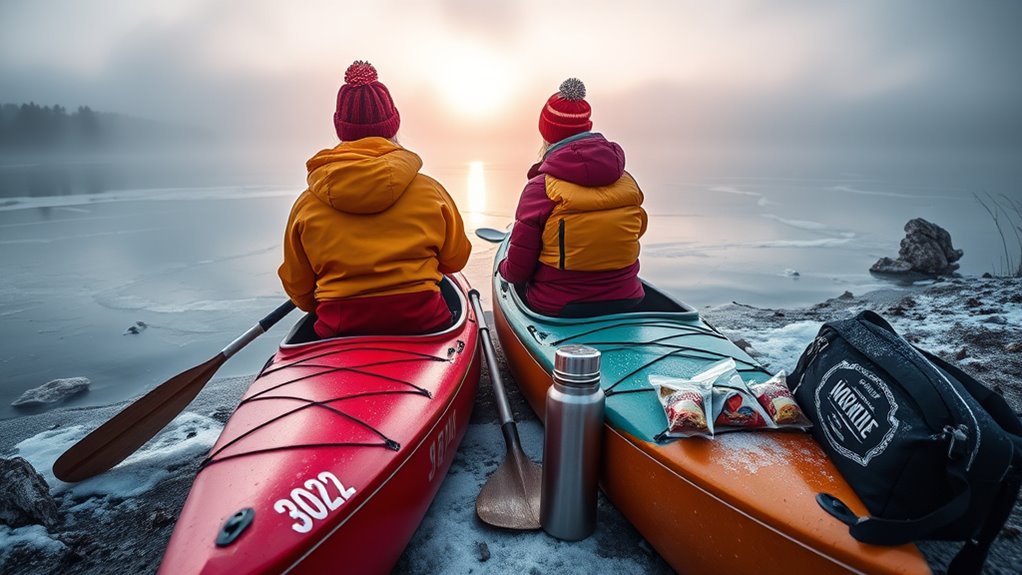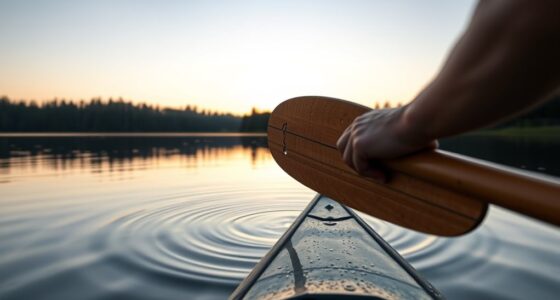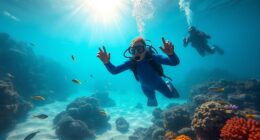Canoeing in cold weather means you need to prepare properly and gear up smartly. Wear a well-fitted wetsuit or drysuit for insulation and layer with moisture-wicking base layers and insulating fleece. Don’t forget waterproof outer layers and essentials like gloves, thick socks, and a warm hat. Always check your canoe for damage and have emergency gear on board. Stay aware of changing conditions and paddle with a buddy. There’s so much more you can learn about staying safe and enjoying your adventure!
Key Takeaways
- Wear a well-fitted wetsuit or drysuit to provide insulation and protect against cold water exposure.
- Layer clothing with moisture-wicking base layers, insulating fleece or wool, and waterproof outer layers.
- Inspect your canoe for leaks and ensure safety gear like throw bags and whistles are onboard.
- Monitor weather conditions and potential hazards like ice formations; inform someone of your paddling plans.
- Always paddle with a buddy for added safety and quick response in emergencies.

Canoeing in cold weather can be exhilarating, but it also poses unique challenges that you need to prepare for. The thrill of gliding through icy waters can quickly turn into a dangerous situation if you’re not careful. One of the first things you should focus on is hypothermia prevention. Cold water can sap your body heat rapidly, and before you know it, you could be in a precarious situation. Always wear a wetsuit or drysuit if you plan to be in the water for extended periods. These suits provide insulation and protect you from the harsh elements. Make sure they fit well to guarantee warmth and mobility.
Canoeing in cold weather offers excitement, but proper gear and hypothermia prevention are essential for safety.
Layering is essential. Start with a moisture-wicking base layer that’ll keep sweat away from your skin, followed by an insulating layer like fleece or wool. Finally, wear a waterproof outer layer to shield you from wind and water exposure. Don’t forget about your extremities; wear insulated gloves, thick socks, and a warm hat to keep your fingers, toes, and head warm. If you can, invest in waterproof footwear that can handle submersion. Hypothermia can set in quickly, so being proactive is indispensable.
Besides clothing, consider your gear. A well-maintained canoe is pivotal for winter paddle safety. Inspect it for any leaks or damage before heading out. Bring along a paddle that you can comfortably grip, even with gloves on. A spare paddle is also a good idea, just in case. Safety gear, like a throw bag and a whistle, should always be on board. You never know when you might need them.
Plan your route carefully. Cold weather can change conditions rapidly, and you need to be aware of potential hazards like ice formations or strong currents. Inform someone about your paddling plans, including your expected return time. This way, if something goes awry, someone will know to look for you.
Keep an eye on the weather. It can turn unexpectedly in winter months, so having a weather app or radio can help you stay informed. Finally, always paddle with a buddy. This isn’t just about companionship; it’s about safety. If one of you gets into trouble, the other can respond quickly. Embrace the beauty of cold-weather canoeing, but make sure you’re prepared to handle its challenges. Additionally, consider incorporating sauna and cold-plunge benefits into your recovery routine after paddling to help with muscle relaxation and rejuvenation.
Frequently Asked Questions
What Are the Signs of Hypothermia While Canoeing?
When you’re canoeing in cold weather, watch for hypothermia symptoms like shivering, confusion, and slurred speech. You might feel unusually tired or notice your fingers and toes becoming numb. If you see someone struggling with these signs, it’s vital to act quickly. Make sure everyone’s wearing proper cold weather clothing to stay warm and dry. If hypothermia sets in, get them out of the cold and seek medical help immediately.
Can I Canoe Alone in Cold Weather?
You can canoe alone in cold weather, but it’s vital to prioritize solo safety. Picture yourself paddling through a winter wonderland, but remember, the conditions can change quickly. Always check the weather considerations before heading out, and make sure you’re equipped for emergencies. Bring extra gear, and let someone know your plans. If conditions seem too risky, it’s wise to wait for a warmer day or find a partner to join you.
How Do I Safely Transport My Canoe in Winter?
To safely transport your canoe in winter, secure it on your vehicle using strong straps or a dedicated rack. Make certain it’s properly covered to protect against snow and ice buildup. Before starting, check the weather and road conditions for safety. For canoe storage, keep it in a dry, sheltered area to prevent damage from freezing temperatures. Always double-check the straps during transport to ensure everything stays secure and safe.
What Should I Eat Before Canoeing in the Cold?
Did you know that your body burns about 30% more calories in cold weather? To fuel your canoeing adventure, eat nutritious snacks like nuts or energy bars, which provide lasting energy. Don’t forget a warm beverage, like hot chocolate or herbal tea, to keep you cozy. These foods will help maintain your body temperature and stamina, ensuring you stay alert and enjoy every moment on the water, even in chilly conditions.
Are There Specific Routes Recommended for Winter Canoeing?
Yes, there are specific routes recommended for winter canoeing. When planning your winter route, consider waterways that remain accessible and safe in colder temperatures. Lakes like the Boundary Waters in Minnesota and rivers such as the Delaware offer scenic views and manageable conditions. Always check for ice conditions and local regulations before heading out. Researching these recommended winter waterways guarantees you have a safe and enjoyable canoeing experience during the colder months.
Conclusion
When you’re ready to brave the brisk beauty of cold-weather canoeing, preparation is key. Packing proper gear and planning your paddle path will keep you cozy and safe. Don’t let the chill chase you away; instead, embrace the exhilarating experience of gliding across glacial waters. With the right mindset and equipment, you’ll conquer the cold and create cherished memories. So, gear up and get ready for a thrilling, unforgettable adventure!










